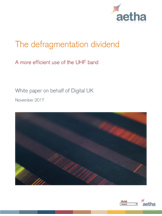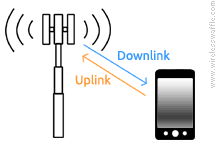Tuesday 21 November, 2017, 10:27 - Broadcasting, Licensed, Spectrum Management
Posted by Administrator
Posted by Administrator
 Digital UK, the organisation responsible for promoting digital terrestrial television in the UK, has recently published a white paper it commissioned from consultants Aetha and Webb Search entitled 'The defragmentation dividend: A more efficient use of the UHF band'. The paper hypothesises that by re-organising the UHF (e.g. sub 1 GHz) spectrum available to mobile operators, it would be possible to use it more efficiently and deliver more service from the same amount of spectrum.
Digital UK, the organisation responsible for promoting digital terrestrial television in the UK, has recently published a white paper it commissioned from consultants Aetha and Webb Search entitled 'The defragmentation dividend: A more efficient use of the UHF band'. The paper hypothesises that by re-organising the UHF (e.g. sub 1 GHz) spectrum available to mobile operators, it would be possible to use it more efficiently and deliver more service from the same amount of spectrum.The paper identifies the fact that, at present, the 'digital dividend' spectrum (e.g. that which has been released from television broadcasting due to the increased efficiency of digital transmission over its old analogue counterpart), is broken up into a number of fragmented pieces whose usage is not optimum. This is certainly true: the figure below shows the current set of allocations within the frequency range 694 - 960 MHz.

The mobile allocations at present are as follows:
| Band | Uplink (MHz) | Downlink (MHz) | Amount (MHz) | Notes |
|---|---|---|---|---|
| 900 MHz | 876-915 | 921-960 | 78 | Including GSM-R |
| 800 MHz | 832-862 | 791-821 | 60 | |
| 700 MHz (a) | 703-733 | 758-788 | 60 | FDD |
| 700 MHz (b) | 738-753 | 15 | TDD or Downlink | |
| TOTAL | 213 | |||
In addition there is approximately 29 MHz set-aside for short-range devices. Thus, of the total of 266 MHz of spectrum between 694 and 960 MHz, 213 MHz (80%) is allocated to mobile services, 29 MHz (11%) for short-range devices leaving 24 MHz (9%) 'empty' (mostly for guard-bands to protect services on adjacent frequencies from interfering with each other). The theory is that by re-arranging the band, it is possible to use all of the small gaps that currently exist between the various mobile allocations (e.g. the 9% that is empty) for more mobile services.
One of the problems of the plans proposed in the report is that although they increase the amount of spectrum for mobile services to up to 250 MHz in their most extreme case, they also reduce the amount available for short-range devices from 29 MHz to just 16 MHz. Whilst you may be thinking, "isn't mobile a better use of spectrum than short-range devices", the fact is that an increasingly wide ecosystem of devices is supported in this spectrum. It includes radiomicrophones and wireless headphones but perhaps even more critically, a growing number of Internet of Things (IoT) technologies that are seen by many as being at the centre of the next stages in the development of the Internet. This includes sensors (e.g. thermostats, light sensors), smart meters (electricity, gas and water) and a wide range of smart-city applications such as transport management. Digital UK's proposed plans involve changing the frequencies used by these devices, which is notoriously difficult. How long, for example, do the keyfobs that unlock your car door last - as long as the vehicle itself in most cases. So clearing a short-range device frequency won't be completed until every device in a band has been replaced by a new one.
The report only pays passing comment to the new 600 MHz mobile band that is being implemented in the USA. In fact, the report seems to suggest that even its most conservative re-organisation option would release so much capacity that there would be no need for the 600 MHz band:
...even the more modest increase of 25% in Option 1 would be similar to the capacity that could be provided by repurposing the 600MHz band...
 It makes this claim as a result of an oddity of current mobile technology, in which the amount of spectrum (and capacity) that is available to a mobile user is roughly equally split in the uplink and downlink directions (e.g. to the network from the user, and from the network to the user respectively). If the band was re-purposed as Time Division Duplex (TDD), the share of uplink and downlink capacity can be changed, and the report assumes that 80% of overall capacity would be made available for downlink and 20% for uplink (this is in fact in line with current estimates of the real split of usage). If this is the crux of the argument, then doing nothing at all to actually change the overall amount of mobile capacity available, but changing all of the existing allocations to TDD would approximately yield a 60% 'improvement' in downlink capacity, but this would be to the loss of uplink capacity which would fall by 250%! There is no gain without pain. In addition, TDD operators in adjacent mobile spectrum need to fully synchronise their networks otherwise there needs to be a guard-band between them, reducing the overall efficiency of use and opening up new gaps.
It makes this claim as a result of an oddity of current mobile technology, in which the amount of spectrum (and capacity) that is available to a mobile user is roughly equally split in the uplink and downlink directions (e.g. to the network from the user, and from the network to the user respectively). If the band was re-purposed as Time Division Duplex (TDD), the share of uplink and downlink capacity can be changed, and the report assumes that 80% of overall capacity would be made available for downlink and 20% for uplink (this is in fact in line with current estimates of the real split of usage). If this is the crux of the argument, then doing nothing at all to actually change the overall amount of mobile capacity available, but changing all of the existing allocations to TDD would approximately yield a 60% 'improvement' in downlink capacity, but this would be to the loss of uplink capacity which would fall by 250%! There is no gain without pain. In addition, TDD operators in adjacent mobile spectrum need to fully synchronise their networks otherwise there needs to be a guard-band between them, reducing the overall efficiency of use and opening up new gaps.Whilst the report makes a valid argument about whether the future of mobile should be TDD or FDD, it is perhaps no surprise that it chooses this solution to theorise about an improvement in the efficiency of use of UHF spectrum, over and above the use of the new 600 MHz band, whose use would obviously entail the loss of (yet) more spectrum for digital terrestrial television. Sadly for Digital UK, the required pain, in terms of re-organising existing mobile networks, and replacing all short-range devices is sadly never going to counterbalance the gain of a few extra MHz of UHF spectrum.
add comment
( 559 views )
| permalink
| 



 ( 3 / 28486 )
( 3 / 28486 )




 ( 3 / 28486 )
( 3 / 28486 )

